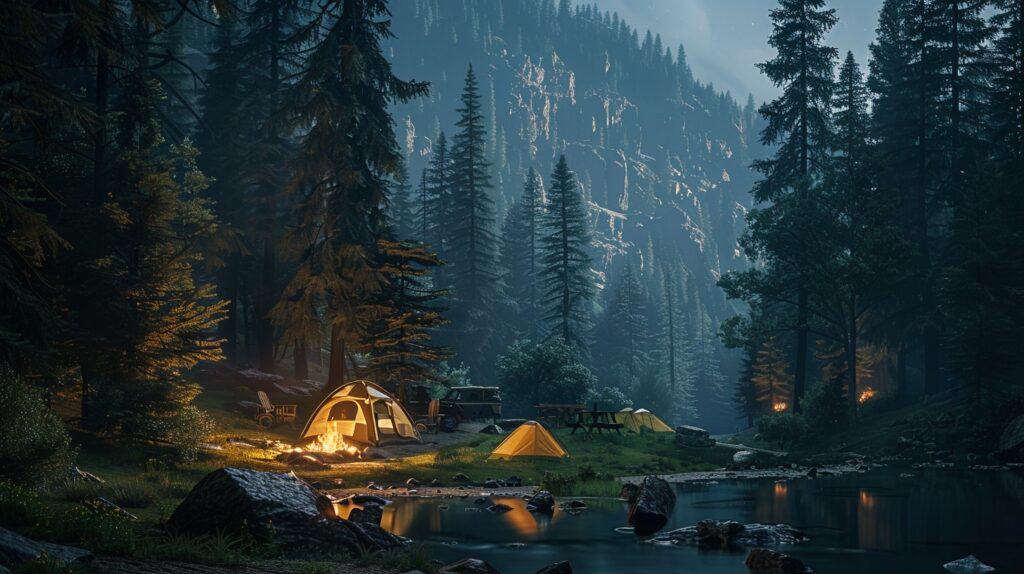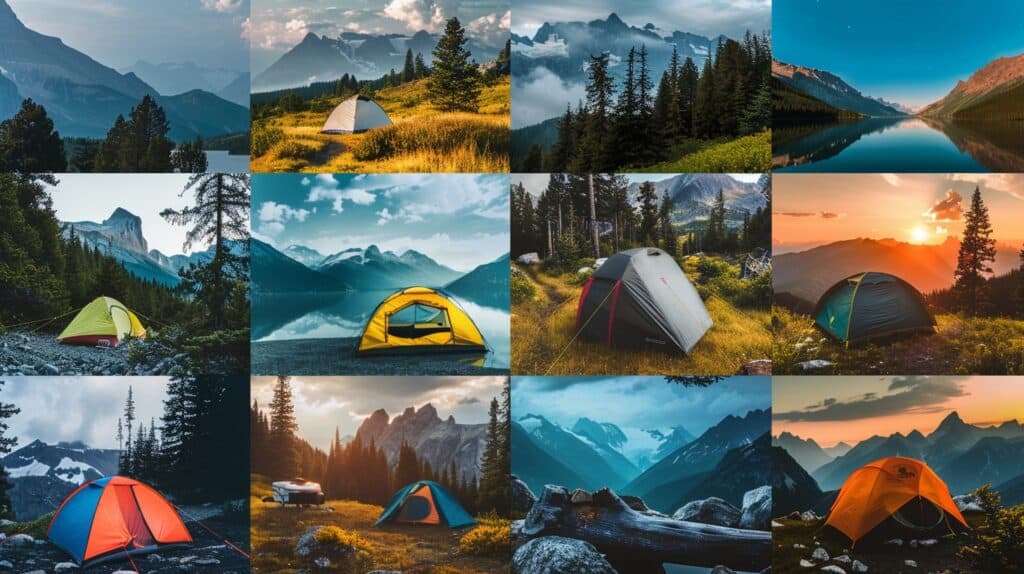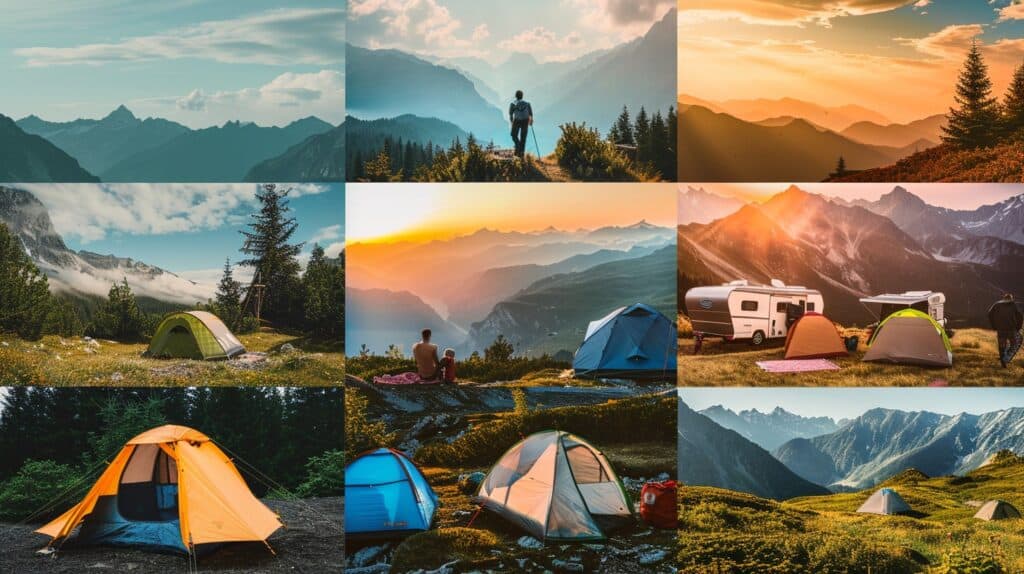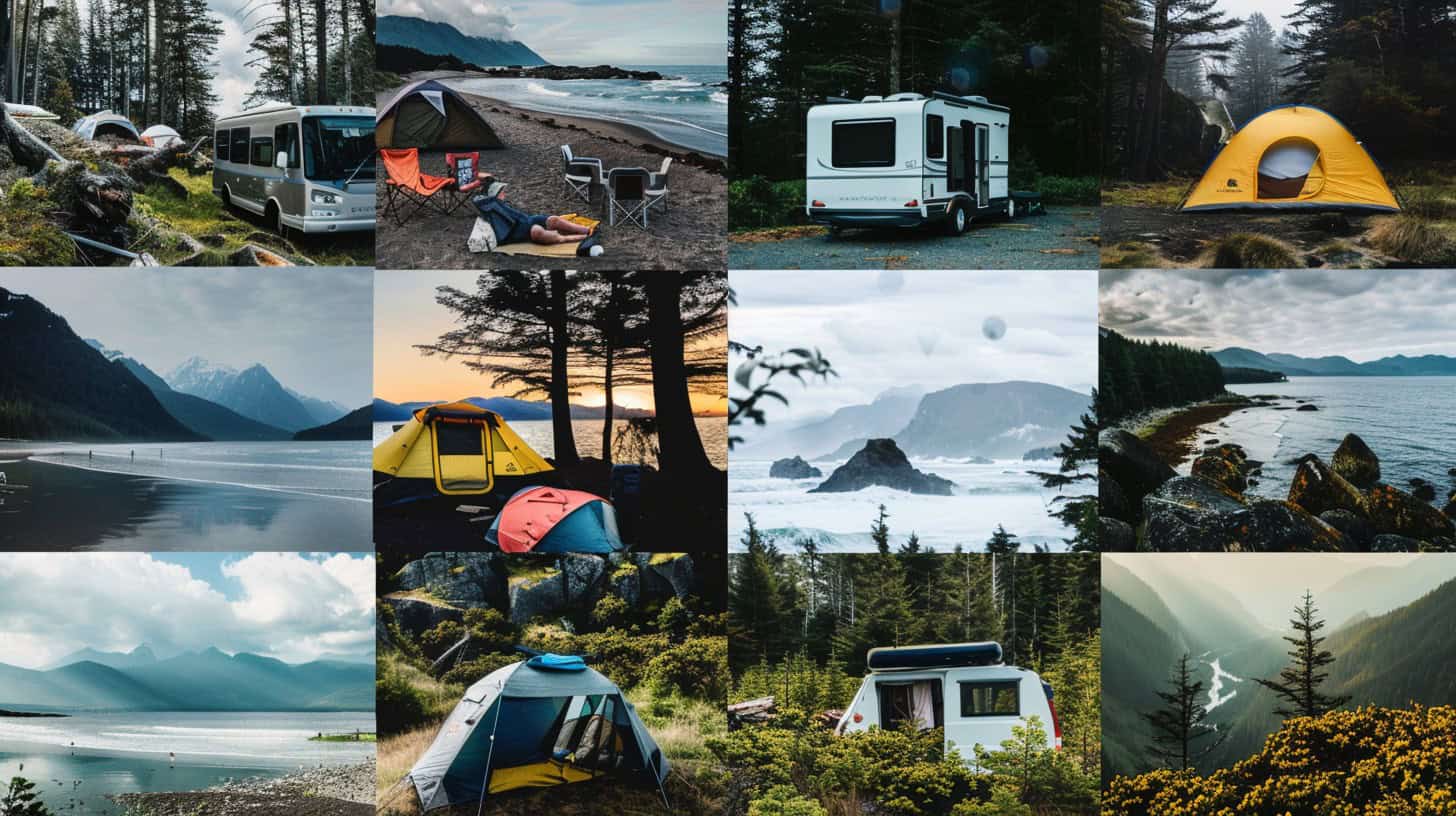Choosing the right camping style can be tough. John Muir led Americans outdoors, proving camping’s timeless appeal. This article breaks down 14 camping types to match your outdoor dream.
Start reading now—find your escape!
Key Takeaways
Camping comes in many styles, from tent and RV camping to ultralight and survival adventures. Each offers unique experiences outdoors.
Important skills like map reading, cooking over a campfire, and setting up shelters vary by camping type, enhancing outdoor knowledge.
Gear needs differ greatly among the camping types; for example, winter camping requires special tents while backpacking focuses on lightweight items.
Planning is key to match camping style with personal interests and skill levels, ensuring an enjoyable experience.
Some types of camping like glamping offer luxury in nature, while others like bivvy sack or tarp camping focus on simplicity and minimalism.
Table of Contents
Exploring Camping Styles

Looking into camping styles opens a world of options…from sleeping under the stars to enjoying nature with luxuries. Each way, like using tents or RVs, brings its own fun and challenges.
Understanding Tent Camping
Tent camping means you pitch a shelter in nature and stay there. You need a tent, sleeping bag, and maybe a campfire to cook. It’s the most basic way to camp. People love it because it brings them close to nature.
In my times doing this, I always pack light but include all essentials.
You find your spot at camping sites or national parks. Tent camping teaches you about outdoor living and survival skills. From setting up tents to cooking on a fire, each step is an adventure.
I learned how important it is to respect nature by leaving no trace behind.
Basics of Backpacking/Hiking Camping
Moving from tent camping, backpacking or hiking camping steps it up. You carry everything on your back. This includes a lighter tent, sleeping bag, food, water, and a stove. It’s essential to pack light but include all you need.
Your backpack becomes your lifeline.
I’ve hiked the Appalachian Trail for days with just my gear. You learn to choose items wisely—like a compact cooker instead of a heavy grill. The experience teaches self-reliance and planning skills.
Map reading and weather watching are crucial too. You’ll find beauty in simplicity—a campfire meal or sleeping under the stars at dispersed campsites becomes unforgettable.
Essentials of Car Camping
Car camping is great for starters. You drive to a camp site and set up next to your car. This way, it’s easy to bring more gear, like coolers full of food or comfy chairs. Most places have showers and places to hang out with others.
With car camping, you truly get the best of both worlds—a night under the stars with all the comforts of home just a trunk away.
You’ll find spots with fire rings for cooking meals over a campfire and sometimes even utilities. Many have restrooms nearby. It’s perfect for meeting people who enjoy being outside at night or those looking for manly hobbies that don’t require carrying everything on your back through the woods.
Winter Camping Challenges
Winter camping brings unique challenges. You need special tents and clothes to stay safe from the cold. I learned this firsthand on a trip last winter. We also needed to know how to pick a spot that wouldn’t get too windy at night.
This means knowing the land and watching the weather closely.
Staying warm is key for any winter camping trip, so we packed extra sleeping pads and brought portable stoves for hot meals. We made sure our gear list included these winter camping essentials plus a survival kit in case of emergencies.
It was tough but worth it for the quiet beauty of snow-covered landscapes.
Guide to RV/Van Camping
RV/Van camping lets you hit the road with all your home comforts. You bring your bed, kitchen, and sometimes even a shower. This style is perfect for those who love adventure but want to keep cozy at night.
You can stay in camp sites across the country, from Yellowstone National Park to Trossachs National Park. Some people choose RVs—big enough for a group, while others prefer vans for a more solo journey.
From my experience, planning is key. Before you leave, check if the places you want to visit have spots for recreational vehicles or need reservations. Also, learn about Leave No Trace principles to keep nature beautiful for everyone.
Gear up with necessary items like cooking tools and hammocks—if you fancy sleeping outside under the stars some nights. Don’t forget outdoor activities gear such as bikes or kayaks if space allows; many sites offer amazing trails or waterways right at your doorstep.
Bicycle Touring Camping Insights
Moving from RV and van setups, we shift gears to bicycle touring camping. This style lets you explore scenic spots using a bike, offering freedom unmatched by motorized travel. Camping with your bike means packing light—choose essential gear only.
Every extra pound matters when you’re pedaling uphill.
I’ve camped in various places, from the Mojave Trails National Monument to Shenandoah National Park. In these adventures, I learned that not all regions offer the same amenities for cyclists.
You might find full-fledged campsites or have to make do with dispersed camping areas. Always check local info before heading out.
Bikepacking is about simplicity… carrying just what you need and nothing more.
Survival Camping Techniques
Survival camping teaches you to live off the land with minimal gear. It focuses on basic needs: shelter, water, and food.
- Pack a small kit with metal containers, duct tape, emergency blankets, candle stubs, band – aids, waterproof matches, safety pins, and fishhooks.
- Find fresh water or know how to purify it using tablets or boiling.
- Learn to make a fire without matches or lighters. Use flint or a fire starter.
- Build shelters from natural materials like branches and leaves, or use a tarp for protection against elements.
- Identify edible plants and insects if food runs out. Carry a guidebook for local flora and fauna.
- Practice navigation skills with a map and compass, since GPS might not be available.
- Develop first aid skills to treat injuries or illnesses in remote areas.
- Use fishing lines or make simple traps to catch fish or small animals for food.
Ultralight Camping Strategies
Ultralight camping cuts down on pack weight. It makes moving through the backcountry easier. Here are ways to do it right:
- Choose a lightweight backpack. Your pack is the start; make sure it’s light yet durable.
- Opt for a bivvy sack or a small tent. This kind of shelter saves weight and space.
- Select a down sleeping bag. It’s lighter than synthetic and packs smaller.
- Bring just enough food and water. Plan your meals and only carry what you will eat.
- Use a small stove or cook over a campfire. Keep cooking gear minimal.
- Wear layers instead of packing extra clothes. This saves space and weight in your bag.
- Pack multi – use items, like a knife that includes other tools.
From my trips, I found using water purifiers better than carrying lots of water bottles. They’re light and make any water safe to drink.
This method demands good planning but pays off by making hikes less tiring.
Next, we dive into overlanding adventures, mixing camping with vehicle travel…
Overlanding Adventures
Overlanding adventures take you off the beaten path, requiring a 4×4 truck to reach places untouched by most. This journey is about long drives in remote areas—mixing driving with nature activities like hiking and kayaking.
You bring all your camping gear, using maps and tools to find your way through wild lands. It’s you, your vehicle, and endless exploration possibilities.
The thrill is in the unknown—you might cross deserts one day and climb mountains the next. Overlanding lets you see hidden gems while living out of your truck or SUV. I’ve seen sunrises that paint the sky colors you can’t imagine, and stars so bright they light up the night ground.
Every trip brings new challenges: finding safe spots to camp, cooking on campfires, and meeting people who share stories around those fires.
Overlanding isn’t just camping; it’s an expedition into nature’s heart.
Glamping Comforts
Glamping blends camping’s natural beauty with home comforts. Think beds, electricity, and indoor plumbing. This style attracts 59% of families, offering a plush outdoor stay without roughing it.
You sleep under the stars but in luxury tents or cabins equipped for convenience and enjoyment.
I tried glamping at a site stocked with amenities: fine linens, private bathrooms, and gourmet meals cooked over an open flame—it felt like a five-star hotel in the wilderness. Activities ranged from hiking to river rafting by day, yet come nightfall, we gathered around a campfire under vast skies.
It redefines camping trips, turning them into glamorous escapes where nature meets comfort effortlessly.
Hammock Camping Benefits
Moving from the luxury of glamping, let’s talk about hammock camping. This style offers a unique twist on sleeping outdoors. It’s all about comfort and ease, keeping you above the cold, damp ground – away from critters that might wander by at night.
With just a lightweight hammock and some tree straps, setting up your bed in nature becomes quick and easy.
I’ve spent nights swaying gently under the stars, finding that sleep comes easier when elevated off the ground. The gear? Simple to carry—a real bonus for backpackers hitting trails like the Appalachian National Scenic Trail or exploring remote areas managed by the Bureau of Land Management.
Plus, with no need for flat surface clearing as tents require, you find freedom in choosing where to rest your head—at lakeside views or hidden forest spots.
Backyard Camping Convenience
Backyard camping lets guys enjoy the outdoors without leaving home. It’s easy to set up a tent or hammock right outside your door. You can grab snacks from the kitchen and even invite friends over for a campfire cookout.
At night, you could share stories or play games under the stars.
This type of camping is ideal for testing new gear before taking it on tougher trips. I once tried out my new sleeping bag in my backyard to make sure it was warm enough for mountain nights.
Backyard camping also means you can practice setting up tents quickly or try cooking different foods on an open fire safely at home.
Next up: understanding bivvy sack camping fundamentals…
Bivvy Sack Camping Fundamentals
Moving from the ease of setting up camp in your backyard, we shift gears to a more rugged approach with bivvy sack camping. This style is for those who crave simplicity and light travel.
A bivvy sack, short for bivouac sack, offers minimal shelter–think sleeping bag with a protective shell against elements like wind and rain. It’s perfect for solo adventurers or at night outings with friends who enjoy being close to nature without the bulk of traditional tents.
Bivvy sack camping shines in its ability to set up camp almost anywhere. From backcountry spots to hidden gems near lakes or mountain bases, this method allows you to explore without carrying heavy equipment.
You need just a few items: a bivvy sack, sleeping pad, and lightweight cooking gear if you plan on making meals over a campfire or portable stove. Outdoor enthusiasts prefer this type for its straightforwardness and direct connection with the outdoors—no fuss about finding large campsites or dealing with complex tent setups.
Ideal for guys’ night ideas where simplicity and adventure meet under the stars.
Tarp Camping Tips
Tarp camping simplifies your outdoor adventures. It uses a tarp as shelter, keeping gear light and setup quick. Here are top tips:
- Choose the right tarp size. Bigger tarps offer more cover but add weight.
- Know different setups. A-frame and lean-to provide good protection and ventilation.
- Practice setups at home. Get familiar with your tarp before hitting the campgrounds.
- Use sturdy poles and tent pegs. Secure your setup against wind at places like Raystown Lake.
- Bring extra guy lines for flexibility in various conditions, especially in backcountry areas like Great Smoky Mountains National Park.
- Pick a spot away from water paths to avoid flooding during rain.
- Angle your tarp correctly against prevailing winds for stability.
- Layer the ground beneath with a footprint or sleeping pad for insulation and comfort.
- Learn knot tying to secure guy lines effectively, crucial for a tight setup.
- Store essentials under the center of the tarp to keep them dry.
This approach ensures you’re ready for nights under the stars, whether planning a solo trip or gathering with friends for an outdoor guy’s night idea near landmarks such as Balloch or Amboy Crater. Cooking on a campfire becomes easier with gear that’s light yet sufficient, making every outing memorable without the hassle of heavy equipment or complicated setups.
Matching Your Style with the Right Camping Type

Picking the right camping style starts with knowing what you like and how much you can do. Think about your favorite outdoor activities, your skill level, and what gear you have or need to get started.
Interests in Camping Exploration
Finding the right camping style starts with what you enjoy. If nights out with friends around a campfire sound perfect, then backyard or car camping could be your match. These styles offer ease to meet people and have those guys’ night ideas come to life.
For men who crave adventure, backpacking or survival camping tests skills and pushes limits. You carry everything on your back, exploring deep woods or mountains.
Your skill level plays a big role too. Beginners might prefer RV or van camping, where you bring comforts of home on the road—think bed, kitchen, and sometimes even an indoor toilet.
This way is great for longer trips to places like Lake Raystown without giving up comfort. More experienced outdoorsmen might lean towards ultralight or bicycle touring camping, challenging themselves with how little they can carry while covering large distances on foot or bike.
In my own experiences hiking through Swatara State Park and kayaking in Afton Canyon, matching activities I love with the right kind of camping made each trip unforgettable. Whether it’s star gazing at Cherry Springs State Park from the comfort of a glamping tent or white-water rafting near Royal Gorge with just a bivvy sack for sleep–knowing your interests guides you to choose wisely for memorable outdoor adventures.
Ability Level Considerations
Choosing the right camping type matters. Your skills and experience play a big role. For guys who love being outdoors, starting simple is key. Think tent or backyard camping first.
These need less gear and know-how. But, for those with more outdoor time under their belts, survival or backcountry camping adds challenge. Here, you pack light – think minimal gear like a small backpack or hammock.
Know what each adventure demands. Winter camping means special tents and warm clothes. RV or van life calls for driving skills plus understanding your vehicle’s needs. The goal? Match your abilities with camping styles to enjoy every night spent under the stars with friends safely and fully.
Resource Assessment for Camping
Before heading out, guys must check what they’ve got and what’s missing. This means looking at camping equipment like tents or RVs. Survival camping? Pack light — bring only essentials.
Thinking about winter under the stars? Make sure you have gear that keeps you warm. Don’t forget to count every item, from sleeping bags to cook stoves.
Next step: plan where you’ll stay. Campgrounds offer different experiences, from quiet spots in the woods to places with showers and Wi-Fi. Think about your trip – does it match your gear list? You might need extra tools for fishing or bikes for trails nearby.
Now, let’s figure out how each style matches your adventure…
Camping Type-Specific Tips

Tips for every camper are crucial. They make trips better and safer. Here are some:
- Tent Camping: Choose a tent that fits everyone comfortably. Know how to set it up before you leave.
- Backpacking/Hiking Camping: Pack light, but don’t forget essentials like water filters and a map.
- Car Camping: Bring a cooler for food and make sure your sleeping area is cozy.
- Winter Camping: Wear layers and invest in a four-season tent to keep warm.
- RV/Van Camping: Check vehicle function before trips. Plan campgrounds in advance.
- Bicycle Touring Camping: Use waterproof bags for gear. Learn basic bike repairs.
- Survival Camping: Learn to build a shelter and start a fire without matches.
- Ultralight Camping: Choose the lightest gear possible without sacrificing safety.
- Overlanding: Map out fuel stops ahead of time, bring spare tires and parts.
- Glamping: Research amenities to ensure they meet your needs for comfort and luxury.
- Hammock Camping: Invest in tree straps to avoid harm to trees, get a rain tarp too.
- Backyard Camping: Make it fun with games, use real camping gear to get the outdoor feel.
- Bivvy Sack Camping: Practice setting it up at home, know how it ventilates to prevent condensation inside.
- Tarp Camping offers flexibility; learn knots for different setups that match weather conditions.
FAQs About Different Types of Camping
What’s glamorous camping?
Glamorous camping, or “glamping,” mixes luxury with the outdoors. Think comfy beds, electricity…even Wi-Fi, all while being surrounded by nature.
Can I camp in a motorhome?
Yes! RV and motorhome camping lets you hit the road with home comforts. Perfect for those who love adventure but not sleeping on the ground.
Is vanlife real camping?
Absolutely! Vanlife is all about freedom and simplicity. Campervans let you sleep under the stars at a moment’s notice—ideal for spontaneous souls.
Where can I find a good camping ground?
“The Dyrt” app or website is your go-to for finding top-rated campsites across the country—whether you’re into rugged backcountry spots or full-service RV parks.
Are there camps just for kids?
Yes, summer camp offers kids outdoor education plus fun activities like hiking and swimming—it’s where lifelong memories (and friendships!) are made.




